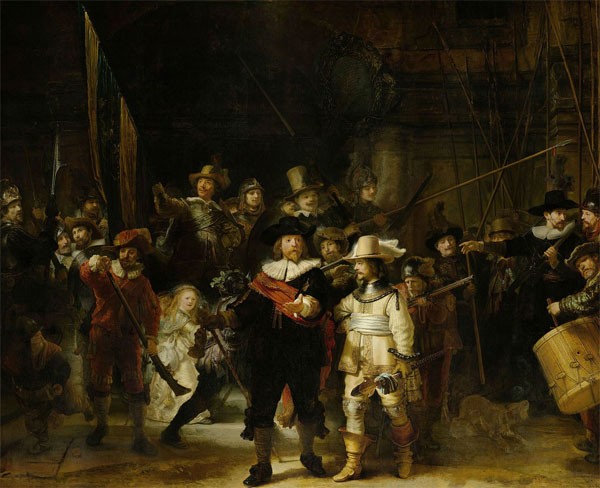Master Facts: Learning from Rembrandt

The Night Watch by Rembrandt has to be a candidate for one of the greatest survivors in Art History. It was widely praised and revered during Rembrandt’s lifetime taking pride of place in the Civic Guardsmen headquarters, the Kloveniersdoelen, but it all seemed to go a bit wrong after Rembrandt’s death.
The most noticeable intervention by custodians of the work was the application of varnish. Rembrandt was known for his thick impasto paint style but this was somewhat at odds with the smooth surfaces that were the norm in 17th and 18th Century – particularly Dutch – Art. Critics advised that his work should be seen from a distance or, worse still, be covered in layers of varnish to try to ‘smooth out’ the surface and so, to make the painting less challenging for viewers, layers of tinted varnish were enthusiastically applied. Over the centuries, the already coloured thick varnish darkened and the painting – originally entitled ‘Militia Company of District II under the Command of Captain Frans Banninck Cocq’ or a variation of that title – became known as ‘The Night Watch’ despite it depicting neither a night time scene or soldiers on guard duty.
With the whole context, title and colour changed, the dimensions of it were altered too. In 1715, it was moved to the Amsterdam Town Hall to honour the great Artist and allow the work to be seen by more people. It didn’t fit so they cut up to 2 feet off each side!
During Napoleon’s occupation of the Netherlands, the Town Hall became his headquarters and the remaining 12 x 14 feet painting was on the move again – firstly to the home of the Tripp family – the Trippenhuis – to save it from Napoleon’s clutches, then back to the Town Hall by order of Napoleon and then back to the Tripps at the end of the occupation in 1813 – almost certainly removed from its frame and rolled on each occasion. The Trippenhuis later became the Rijkmuseum and the Night Watch remained there until 1939 when, with the outbreak of war, it was, yet again, taken off its stretchers and rolled up for safe storage.
To add to its woes, it became a victim of vandalism on separate three occasions during the 20th century, – slashed with a knife in 1911, a second knife attack in 1975 and an acid attack in 1990. Despite the extensive repairs that it has had to go through, the painting, today, has surprisingly few battle scars and the expertise of the restorers has successfully revealed Rembrandt to be the great colourist that he was and given the Night Watch a much brighter future!
